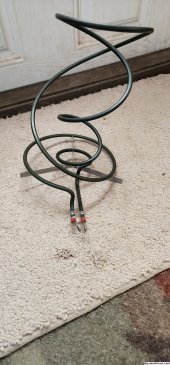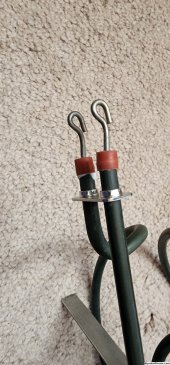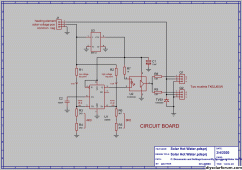Ceefiveceefive
New Member
- Joined
- Sep 28, 2019
- Messages
- 94
Greetings!
I am going to assemble my larger sand battery I posted about here: https://diysolarforum.com/threads/sand-battery-experement.67368/
I have made a few slight changes & have purchased a large metal barrel measuring 6' tall and a 4' diameter. Before I start assembling this large outdoor sand battery, I want to do a smaller indoor prototype with a few deviations.
This video is basically what I want to do:
Instead of using a plastic bucket and a coffee can for containers, I will use a small metal trashcan inside of a larger one.
I will use 2 elements stretched out (see pics) evenly in the small trashcan along with aluminum bars throughout to help transfer heat. The elements are rated 2100 watts each.
Questions:
1. How should I attach the solar panels safely to the element connections? (See pic)
Is it safe to attach PV wire straight to the connectors?
2. Is it advisable to attach the elements in series or parallel?
3. What is a good estimate of how many panels I will need to attach to the element connection? I have a variety of panels including 240 , 250, & 270 watts.
Thanks! If clarification is needed, let me know!
I am going to assemble my larger sand battery I posted about here: https://diysolarforum.com/threads/sand-battery-experement.67368/
I have made a few slight changes & have purchased a large metal barrel measuring 6' tall and a 4' diameter. Before I start assembling this large outdoor sand battery, I want to do a smaller indoor prototype with a few deviations.
This video is basically what I want to do:
Instead of using a plastic bucket and a coffee can for containers, I will use a small metal trashcan inside of a larger one.
I will use 2 elements stretched out (see pics) evenly in the small trashcan along with aluminum bars throughout to help transfer heat. The elements are rated 2100 watts each.
Questions:
1. How should I attach the solar panels safely to the element connections? (See pic)
Is it safe to attach PV wire straight to the connectors?
2. Is it advisable to attach the elements in series or parallel?
3. What is a good estimate of how many panels I will need to attach to the element connection? I have a variety of panels including 240 , 250, & 270 watts.
Thanks! If clarification is needed, let me know!
Attachments
Last edited:








